On June 6th, 2015, I married the love of my life in London, wearing my Irish Lace inspired gown. The entire process of making the dress began in mid-October 2014 and was finished moments before the ceremony! All told, it took right around 1,000 hours to crochet, block, and assemble the lace, which used just over 7,000 yards of thread. The underdress was made of silver satin and was designed and assembled by Amy Jeskins, a London costumer and long-time friend of my husband. The total materials for the dress were about £70 (£20 for the thread, £50 for the satin), with an additional £60 spent on corseting and petticoats.
How it all began
In September 2011, a friend and I decided to attend a weekend
gaming con in Arizona on a lark, and while there I met Andy, an Englishman on holiday in the States. We hit it straight off and were inseparable for the rest of the long weekend, bonding over card games, Doctor Who, and Thai food. I was finishing up a masters degree in Oregon (where I was born and raised), and my daughters were nearing the end of high school and planning their own moves to University. Thanks to the magic of Skype and Facebook, we stayed in touch every day and began planning our next holiday together.
Fast forward three years and to the UK, where Andy and I were now living together in a lovely little flat in the Home Counties (about an hour's train ride from London). For our three year anniversary we decided to go back to where we had met...Mesa, Arizona and to attend the con that first brought us together. On the last day of our stay in Arizona, Andy took over the pub quiz and used the final question to
propose. All of a sudden the theoretical wedding we had been talking about for months was a very real event with a date on the calendar and everything! We visited my family in Oregon, hosted an engagement party, and returned home to start planning in earnest.
We started by booking the church where my 4th great-grandparents had married in 1839, asking bridesmaids and groomsmen to stand up with us on the day, enlisting our favourite pub in London for the reception...and choosing wedding colours. Initially I had in mind a
purple Quinceanera dress, and while I loved the shape, I did not love the idea of wearing a strapless dress, as I have tattoos on my shoulders and wanted them to be covered during the ceremony (I love tattoos, I just don't love seeing bits of them sticking out from behind wedding dresses). So I started thinking about other options...and then I got inspired.
A Crazy Idea
It all began with a girl on a bus. No, not me. This lovely lady who posted
her crocheted wedding dress to Reddit. I loved her dress and it set me to looking for other
crocheted dresses to see what was possible. I came across several traditional Irish Lace dresses and before long I stumbled upon the
Antique Pattern Library and decided to try my hand at making a few pieces from their catalog. I started with a #10 weight yarn a friend had gifted me with and then some embroidery weight floss and tried a couple of pieces from the antique pattern books. The stitches were easy enough, but there is definitely a learning curve switching from worsted weight yarn to thread and it took several pieces before I felt confident that I could master lace work in the nine months between our engagement and the wedding date!
 |
| Trying different weights of yarn |
In mid-October I picked up some
Coats Moon sewing thread in three shades of purple and two shades of silver, and two shades of white. I initially thought one strand would be enough, but quickly realized two strands would be needed to make the lace have enough weight to be workable once blocked.
 |
| Coats Moon threads |
I made several test pieces (in white) and while they were a bit rough before blocking, I felt I was on to something.
 |
| An Irish Rose |
Next I picked up Kathryn White's excellent guide,
The Go-to Book for Irish Crochet Motifs and while on the train to Hull for Guy Fawkes Night I made several pieces that were actually used on the dress. This book does a great job of guiding the reader through traditional pieces using a padding cord and modernized pattern work (which relies more on chains than padding cords). The one downfall to the book is that the patterns are written out, rather than charted (as is the case with the entirety of books found on the Antique Pattern Library), so it was much more difficult to multi-task while crocheting.
Throughout November I made several pieces which were mainly done in white. However, it didn't take long to realize that I did not want a white dress, so again, we went back to the quinceanera dress for inspiration. I started using two shades of the other colours (silvers and purples) and while it gave the pieces some dimensions, I decided in the end that I was not as fond of the reddish purple as I thought I would be, so I used these early pieces sparingly in the final dress.
There was a very long break in working on the dress in November and December, as my daughter's first winter in Indiana required some serious intervention in the way of gloves, scarves, headbands, and hats. I also had the mad idea to crochet bags for my girls's
advent calendars (seriously, this was MAD). I spent a solid six weeks working on all of these projects, so the dress was on the back-burner until their holiday packages were put in the post.
At Christmas, my in-laws gave me two books Caitlin Sainio's
100 Lace Flowers to Crochet and Lesley Stanfield's
100 Flowers to Knit and Crochet. Both books are wonderful and contain excellent charts, though Sainio's book was more useful to me, as all of the patterns are for crochet. We spent Boxing Day with Andy's family and I made several pieces, all of which were chosen by aunts and uncles from the new pattern books. On our wedding day it was great fun to point out the pieces chosen by family and friends, these were the first of many!
After New Year's, the pieces started coming fairly quick. By mid-January there were about 35 pieces in the jar. Most ended up on the dress (though not the amoeba, which was a free form piece made on the train one afternoon). The pieces below measured just over one foot square when set next to each other.

 |
| The box full of bits |
The Point of No return
The last week of January I took on the biggest project to date... The Polish Stars. 31 rounds of crocheting, 14" wide (they would be 16" wide once blocked), each taking nearly 800 yards of thread and between 70-80 hours of crocheting. Like all of the other pieces, they were made with a 1.5mm crochet hook. Five of these pieces were sewn (tacked) to the train of the dress. My best estimate is that the entire process of crocheting, blocking, and tacking these pieces alone took about 450 hours and four spools of Coats Moon thread (made in the lightest shades of purple and silver, one strand of each) totaling 4000 yards of thread. At this point I had easily spent 600 hours on the dress and while I still wasn't sure what the finished dress would look like, I realized there was no turning back.


One thing I wanted to add to the dress was a motif which was repeated throughout St. Pancras Church. I liked the idea of bringing the history of the church into the dress and including a piece of our family connection to the parish in the dress (as Andy's 3rd great-grandfather was also born and lived in St Pancras at the same time my family lived there).
 |
| The St Pancras Motif |
In mid-March I met with Andy's dear friend Amy, a costumer in London, to work on designing the underdress. While I can sew, it is not my forte and I don't own a sewing machine, so I was so incredibly grateful for her skills. The design did undergo some changes, as Andy requested that I not have any sleeves, so while we did reach a compromise of slightly capped sleeves to be sure that my tattoos were covered, I acquiesced and scrapped the "Downtonesque" sleeves of the initial design. We also ended up not having the heart cutout in the back, as it was exposing bits of the tattoo and was incredibly tricky to crochet around, so we went with a solid back. The bustle also ended up being rather full, so having the back edge of the bodice come higher up made more sense than trying to bring it down below my hips and disrupting the flow of the train.


Andy also made another request in March...that I add a darker purple to the dress to match the vests he had chosen for his suit. This added a real challenge to the placement of pieces, as I was really worried that it would look far too busy. I began making darker pieces (mainly in traditional Irish motifs) and hoping inspiration would strike again. I came across this
ombre dress and decided that the best idea was to begin with the darkest pieces at the top and to move into the lighter colours as I worked down the dress. The pieces were also more dense at the top and had a bit more open webbing at the bottom of the bodice as I was trying to avoid it looking
super busy. The fading from the darkest colours at the top down to the pale silver of the underdress and Polish Stars ended up being the right decision as it opened up the skirting and bustle instead of burying it under a web of dark colours.
I had my first toile fitting at the end of April, which ended up being just about the right time. I had lost three stone and was feeling good enough about where I was at that we didn't have to make major alterations later. So while we did have two more fittings to fine-tune the length once my shoes arrived, take out the bust after Bravisimo gifted me with a fabulous bra set, and to adjust the bustle once the underskirting arrived, it was a pretty straight-forward process.
Blocking the Lace
Next came the blocking, the process of stretching the pieces into shape and starching them so they stay formed. Here is an example of a poinsettia before and after being blocked. As you can see, once it is pinned you can really see the intricacy of the design.
 |
| Poinsettia before and after blocking |
Blocking does require a few materials:
- A gentle fabric soap (I used Woolite)
- Corn starch (called corn flour here in the UK)
- Sodium Crystals (if you have hard water)
- Towel
- Blocking mats (I used inexpensive play mats)
- Pins. So so many pins (I used about 5,000 pins)
First,gently wash the pieces in Woolite (check that your thread is colourfast by washing one of the darkest pieces first and making sure the water does not change colour). Rinse multiple times in warm and then cold water.
Next, you must boil the corn starch (or corn flour here in the UK) until it is clear. Finding the right ratio of starch to water just takes some trial and error. Luckily, if you add too much starch you can rewash the pieces and start the process over. You want the pieces firm, but not hard, as obviously for a dress you want the pieces to move with the material.
 |
| Boiling the corn starch |
Next, the pieces are soaked in a bit of sodium crystals (as we have very hard water) and then they are soaked in the corn starch (directly out of the pan, so it is not quite boiling, but is very hot) for at least 20 minutes. This allows the fibers to be loosened and prepared to stretch into shape.
 |
| Wash in Woolite, rinse, give a quick dip into water softener, and then starch |
The advantage of the Coats Moon thread was that it is colour fast, so I didn't have to worry about the colours bleeding or fading.
 |
| Soak for at least 20 minutes |
The pieces are then drained (Gently! Do not twist them, as the patterns will warp).
 |
| Draining the pieces |
 |
| The pieces are then pressed onto a clean towel, again, not wringing them. |
And then they are pinned into place and left to dry over night. I have 12 mats, each is a one foot square...it took about five nights to block all of the pieces. The most important thing to remember when blocking is to balance your placement of the pins from side to side. Start by pinning the north and south pieces, and then east and west, northwest and southeast, northeast and southwest, etc. This allows for even stretching of the pieces. Also, each picot must be pinned. Let me tell you, on pieces like the Polish Stars, which have 100 picots around the edges alone, this is a lot of work, but most of the pieces went fairly quick.
 |
| One night's worth of blocking! |
 |
| Blocking |
Shaping the Pattern
On May 15th I had my final fitting and Amy gave me the pattern for the dress...and this is when the chaos truly began. Up to this point the crocheting had been difficult, but it was all within the norm. I had learned a lot, managed to figure out how to work with the sewing thread and 1.5mm hook, and had navigated blocking, weaving in all of the ends, and had a pretty good idea of how the colours would work from top to bottom. But let me tell you now, nothing had prepared me for learning to crochet in 2D. Pinning pieces to a piece of paper and foam board and then crocheting them together is probably the most challenging thing I have ever done with a crochet hook. I'll walk you through the process as best I can, but until I post the video (which will happen sometime later this month!) I think it will be hard to truly visualize the process.
 |
| The nearly final fitting |
First, I copied all of the pattern pieces on to wrapping paper (which is rather thick and was durable enough to manipulate, pin, etc.)
 |
| Pattern pieces |
 |
| Trying out different placements. In the end almost all of the lightest coloured pieces ended up tacked to the hem. |
I actually ended up cutting the pattern out twice so I could work with it in a few different ways. First in solid pieces from left to right as they would be in the bodice (so back seam (L), side back (L), side front (L), front, side front (R), side back (R), back seam). These pieces were labeled 1-7 and then cut into half about an inch below the final matching point (just below the bottom of the button line). An additional 3 godet pieces were cut out for the train.
 |
| The bodice was made up of seven panels. The dark spots were the places where the patterns had to line up. |
The train was made up of five panels (three of these were technically godets, as they fit between the side back and back pieces, making a total of seven panels in the back/bustle). The Polish Stars were tacked to the hem of the train after I decided that webbing over the bustle would basically be impossible given that I had only three weeks to do all of the webbing.
 |
| The train and godet pieces taped together |
 |
| Polish Star - 16" wide once blocked |
Andy asked me to teach him to crochet so he could help chaining around the points of the Polish Stars. This was supposed to help with the webbing, but once it was decided they wouldn't be webbed, it actually made them that much more difficult to tack to the hem. Hindsight!! He took his crocheting on the train with him to work for a week and was actually going pretty quickly by the time he finished the last piece.
 |
| Andy learning to crochet |
Learning to Web
And then the webbing actually began. Let me say again, just how difficult this process was. It took days of starting and stopping, trying to decide which colour to use, trying to picture how the transitions would work, how close the pieces should be, the best way to handle pieces that crossed over panel borders, etc. I had first debated using darker thread and carrying on the ombre colouring, but there just wasn't a way to make the transitions even and it would have looked pretty mental I think. Up close and in person the stitching showed up a lot more than it does in the ceremony photos.
There are a few videos on the process on youtube, but none of them are in English, so while I was able to watch the technique, there is definitely something to be said for getting talked through the process. The antique pattern books and Kathryn White's book have some text on creating mesh blocks, but these tend to rely on making the mesh first and then tacking pieces on top, which is visually quite different, and in the end I believe it would have taken more time, which three weeks before the wedding, I just did not have.
The bodice panels were all joined together, except at the middle back seam, which had fabric covered buttons (which were then buttoned into the webbing). Andy was a darling and sewed the buttons on for me while I worked on the front panels, which was a great help. The only downside to the buttons was that I couldn't wear my hair down, as it is waist length and constantly got tangled. Even having my hair braided during the ceremony wasn't enough, so it had to be pinned up during the reception. In retrospect, I would have gone with a proper up-do had I known how much of the night would be spent unraveling my hair from the buttons!
 |
| The Back Panels |
I really expected the bodice to weigh a lot more than it did. I'm not sure why, as holding seven spools of thread in my hand weighed almost nothing and the bodice didn't even have the plastic spools! The entire bodice weighed less than one kilogram once assembled. I made the capped sleeves rather dense expecting them to need to bear weight, but they also served the dual purpose of covering the tattoos on my shoulders, so while I do wish they had curved a bit more, I do love the shapes of the individual pieces.
 |
| The front side and back side pieces joining together |
When you are webbing, the pieces are put wrong side up and then stitched together (using a combination of chains and mainly triple stitches or double triple, etc.) so that once they are turned over right sided they look like they are floating on top of the webbing. The process is very organic and any attempt to make all of the chains the same length is soon abandoned. As a general rule I started with 5-7 chains, but some were shorter and many were longer.
 |
| Beginning the webbing |
 |
| A half completed panel. |
Each panel of the bodice was webbed nearly to the edge of the pattern. I then pinned the joining spots, unpinned the entire piece, lined the pinned spots up with the joining spots on the next panel, pinned enough other spots to block the piece, and started the whole process over again...seven times.
 |
| Joining two panels together |
The individual pieces of the capped sleeves were sewn together using a running whip stitch (rather than webbing between them). These were the last pieces to be stitched to the bodice, as I wanted to be sure that they were placed in a way that would line the bodice up to the underdress. They were initially attached to the front and then Amy pulled them down and tacked them in the back as the final step of getting ready to head to the ceremony.
 |
| The capped sleeves mocked into place |
The Sunday before the wedding I had the actual final fitting with Amy and the bodice was close to being done, but not nearly done enough! And we still had cakes to bake, flowers to put together, and so many other little details to finalize before Saturday! At least at this point I felt that it was going to be possible to finish, though I was still trying to visualize the bottom border of the dress, as having it a straight line was not appealing.
 |
| The actual final fitting |
Wedding Day!
When D-Day arrived, it had already been a very long night. After the rehearsal and dinner, Andy headed to his hotel room, and I headed to the apartment we had rented in the city and got back to work. I crocheted until four AM, took a nap of about two hours, and then got back to work.
 |
| The morning of the wedding! |
My daughter Gabby finished tacking the light coloured pieces to the hem around noon (while my other daughter, Bridgette, was at the reception venue assembling the cake and making our bouquets!). This was an amazing feat, as Gabby had never sewn before and asked if I would teach her (the Tuesday before the wedding!) so she could help!
 |
| The nearly naked underdress |
 |
| One of the Polish Stars tacked into place. |
The ceremony was set to being at quarter after five, so I had to be done with the bodice by three so I would time to have my hair and makeup done, read Andy's letter, and just relax for a moment. Everyone was incredibly anxious during the morning, but once I saw the end in sight and had an better idea of how the bottom edges would work (allowing the larger pieces to shape the edges by only webbing the upper halves) I was much more zen about the whole dress.
 |
| Close up of the front Bodice |
Once I was done with the bodice, I handed it off to Gabby and Amy to make sure all of the ends were woven in. Amy then began tacking the bodice to the dress, putting the final stitches in the shoulders once I was in the dress.
 |
| Amy and Gabby weaving in ends. |
 |
| The back of the bodice piece |
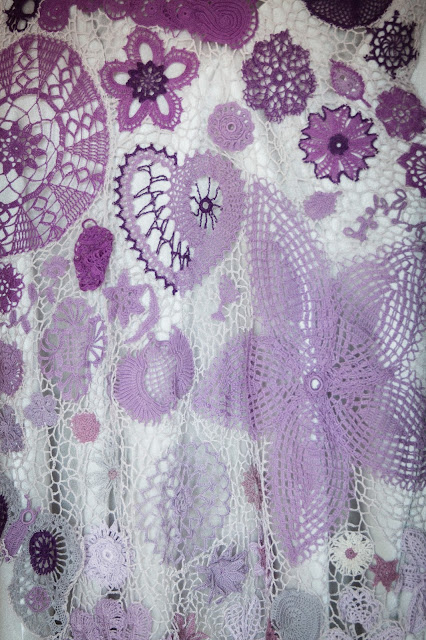 |
| Front of the bodice |
 |
| Almost ready |
 |
| Just a few more stitches |
 |
| The hardest button to button |
While I was getting buttoned in, my maid of honour (Saphia) was racing around King's Cross station trying to find a cab to take us to the church. The moment the last button was done up, we hurried down the stairs and around the corner to the cab and its very excited driver, glad to play his part in our adventure!
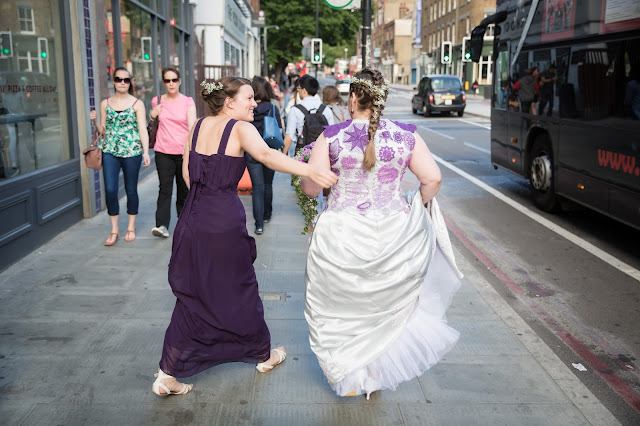 |
| I've got a bride to get to the church! |
 |
Here we go!

Arriving at the church |
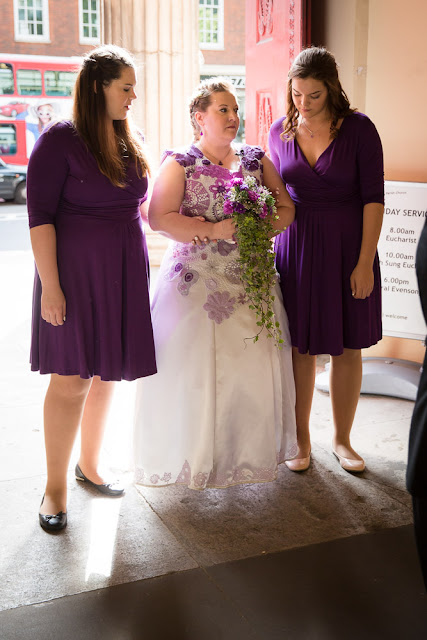 |
| My daughters, ready to walk me down the aisle |
 |
| My one regret is that we didn't get any pictures of the train properly fanned out! |
 |
| I love this photo of the groomsmen! We call this "He loves me, He loves him, That's Amazing, What is this sorcery? |
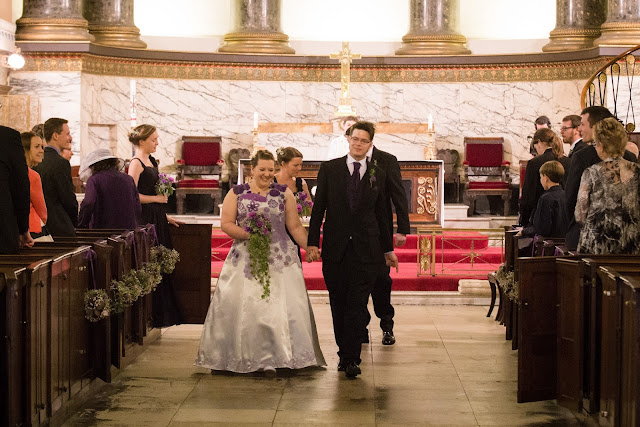 |
| Andy quite literally danced back down the aisle. He is such a goober. |
 |
| This one is called Overwhelming Joy! |
 |
| Being blinded by the sun...also, so much satin! |
 |
| Confetti time and the best shot of the dress's shape before the bustle was buttoned up |
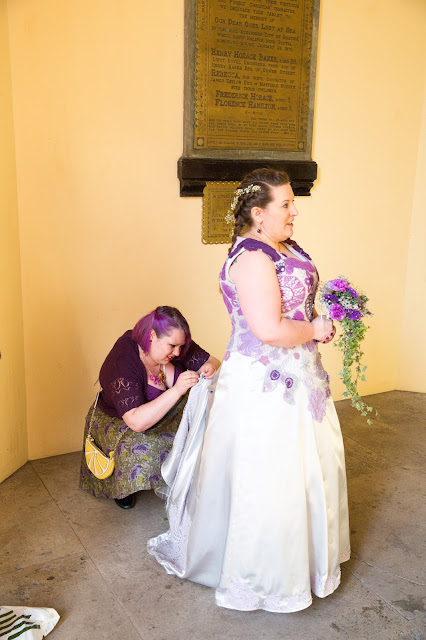 |
| The train and bustle were held up with nine little buttons |
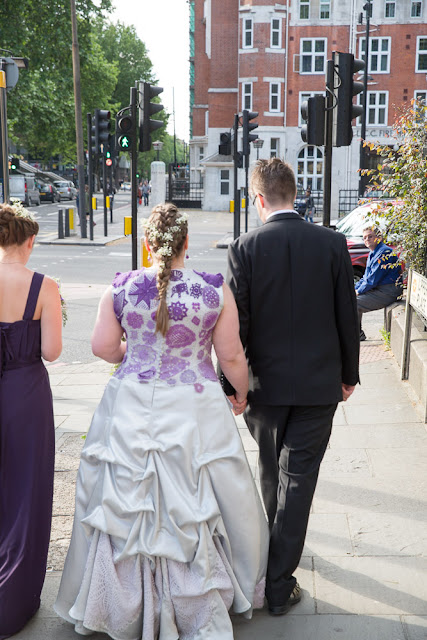 |
| All bustled up and ready to go! |
 |
| Arriving at King's Cross Station on our way up to the reception (held inside the Parcel Yard) |
 |
| Arrival drinks! |
 |
| Trying to find the special pieces hidden in the hem |
 |
| Our first dance (to Lullaby by the Dixie Chicks) |
 |
| And they lived happily ever after. |
Wedding day Photo Credit: Mike Taylor of
SimpleImages.co.uk.
All other photos are mine: @taniapdx
Please do not repost this blog or photos without permission. If you would like to share our story you *must* ask for permission and credit photos.





























































